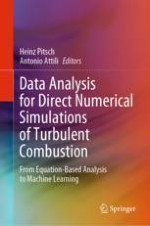2020 | OriginalPaper | Chapter
12. Analysis of Turbulent Reacting Jets via Principal Component Analysis
Authors : Giuseppe D’Alessio, Antonio Attili, Alberto Cuoci, Heinz Pitsch, Alessandro Parente
Published in: Data Analysis for Direct Numerical Simulations of Turbulent Combustion
Publisher: Springer International Publishing
Activate our intelligent search to find suitable subject content or patents.
Select sections of text to find matching patents with Artificial Intelligence. powered by
Select sections of text to find additional relevant content using AI-assisted search. powered by
Abstract
MATLAB® code. Finally, the methodology is applied to data obtained from a DNS of a turbulent reacting non-premixed n-heptane jet in air. The latter can be regarded as an optimal case for data analysis because of the complex physics characterized by turbulence–chemistry interaction and soot formation.